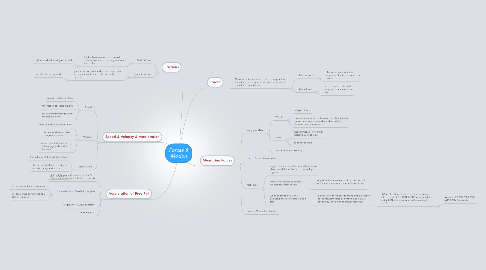
1. Frictions
1.1. Static friction
1.1.1. friction between two or more solid objects that are not moving relative to each other
1.1.1.1. ex) a car wheel moving on a road
1.2. Dynamic friction
1.2.1. dynamic friction occurs when two objects are moving relative to each other and rub together
1.2.1.1. ex ) sled on the ground
2. Speed & Velocity & Acceleration
2.1. Speed
2.1.1. speed = distance / time
2.1.2. how fast an object is moving
2.1.3. scalar quantity(described by magnitude alone)
2.2. Velocity
2.2.1. velocity = displacement / time
2.2.2. the rate at which an object changes its position
2.2.3. vector quantity(described by both a magnitude and a direction)
2.3. Acceleration
2.3.1. final velocity - initial velocity / time
2.3.2. the rate at which the velocity of a body changes with time
2.3.3. vector quantity
3. Acceleration of Free Fall
3.1. A free falling object is an object that's falling under the sole influence of gravity.
3.2. Chracteristics of free-falling objects
3.2.1. Do not encounter air resistance
3.2.2. All accelerate downwards at a rate of 9.8m/s/s
3.3. G (gravity) is always constant
3.4. F = mg = ma
4. Forces
4.1. Newton's third law states that for every action force there is an equal (in size) and opposite (in direction) reaction force
4.1.1. Reaction force
4.1.1.1. the force that acts in the opposite direction to an action force
4.1.2. Action force
4.1.2.1. the force which acts on the body due to some external effort
5. Measuring Forces
5.1. Weight & Mass
5.1.1. Weight
5.1.1.1. a type of force
5.1.1.2. weight of an object -> force on the object due to gravity and can change depending on the location (earth, moon etc)
5.1.2. Mass
5.1.2.1. measurement of how much matter is in an objects
5.1.2.2. does not change
5.1.3. Weight = Mass x Gravity
5.2. Unit of force = Newton (N)
5.3. Net Force
5.3.1. single force that has the same effect on the object as all the individual forces acting together
5.3.2. when all forces are balanced, the resultant force is zero
5.3.2.1. a body will either remain at rest or continue with constant speed unless an external force acts on it
5.3.3. When all the forces aren't balanced, the resultant force isn't zero.
5.3.3.1. a body will either begin to move in the direction of the resultant force or a moving object will speed up, slow down or change direction
5.3.3.1.1. EXAMPLE : When a car is moving Eastwards with a thrust of 20,000N, 2000N of air resistance and 5000N of friction, what is the resultant force?
